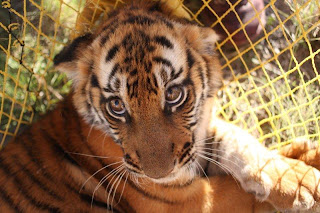-Authored by Li Quan
I would like to thank the many scientists who gave me input in drafting this document, which is an accumulation of my 13 years of tiger conservation work, which started in 1999.
At the International Wildlife Management Congress (IWMC 2012), the South China Tiger Rewilding Guidelines was officially released. Since 2003, I have undertaken an unprecedented project to rewild zoo-born South China Tigers in South Africa to prepare them for their eventual return to their natural habitat in China in conjunction with China's Wildlife R&D Centre of the Forestry Academy. This pioneering project was ground-breaking in many areas: applying an unconventional approach and utilizing the expertise of a different country in a foreign location to fast-track the recovery of the most ancient, yet most endangered tiger in the world.
Below is an abstract of the Tiger Rewilding Guidelines that I have applied and a full version in both English and Chinese can be obtained here: http://www.savechinastigers.cn/file/2013/RewildingGuidelines.pdf
Abstract*
Many wildlife management projects have been conducted throughout the world that may involve: rehabilitation, re-introduction or translocation. Few of these activities have successfully been conducted using captive bred predators. Rewilding describes the processes in which carnivores that have been in zoo conditions for generations and have no survival skills for the wild, re-learn the hunting and skills in a natural environment to prepare them to be reintroduced to the wild.
The South China Tiger (Panthera tigris amoyensis) is recognised by the IUCN as the most endangered of the remaining six extant subspecies of tigers. There are believed to be fewer than 30, if any at all, left in the wild. The only option to revive this tiger in the wild is through reintroduction of captive-bred individuals. OUr project aims to utilise rewilded captive bred tigers and their offspring as catalysts to restore and secure habitat for their release in China. In the wild, offspring of tigers are known to spend up to 28 months with their mothers when they acquire and develop hunting and survival skills. Captive-bred tigers lack these essential hunting skills and need to be rewilded before they can be reintroduced.
Tiger rewilding initially started in China in the 1990’s. South Africa was used to fast track the rewilding project. Five tigers were transferred from zoos in China to South Africa since 2003.
The tigers have been confined to one area of the reserve, subdivided into different-sized camps (0.5 to 100ha), depending on objectives for individual tigers. The number of camps increased over the years as the number of tigers increased, and the sizes of the hunting camps were modified as tigers became more experienced and skilled, and to accommodate the tigers’ development and mimic their movement according to their age. The tiger camps are secured with electrified fences.
There are three categories of camp sizes, according to the age of the tigers and their ability to hunt: quarantine/smaller camps, intermediate camps, advanced rewilding camps. All camps are equipped with natural or supplemental water supplies.
The Rewilding methodology was initially developed for us by Gus Van Dyk, former Carnivore Manager at Pilanesberg National Park of South Africa, and been fine-tuned throughout our rewilding programme, which has followed “Adaptive Management” procedures. The methods have evolved as the project progresses, to suit the changing needs and situations.
Zoo-born tigers that originated from China, were introduced to ungulate prey where rewilding involved “self-taught” or "trial and error" learning. Second generation tigers born in South Africa, were rewilded by: 1) learning survival skills from their mothers-“Natural Learning (NL)”, and 2) a combination of mother-teaching and NL without their mother’s accompaniment.
Components such as “Pavlov” training, prey species and their sizes, animal and human safety procedures, human habituation, veterinarian provisions, data collection/monitoring, treatment, and ethics are discussed in the rewilding guidelines.
Details of fencing structure, camps characteristics, prey species for hunting training and feeding, as well as monitoring sheets are also included in the rewilding guidelines.






































